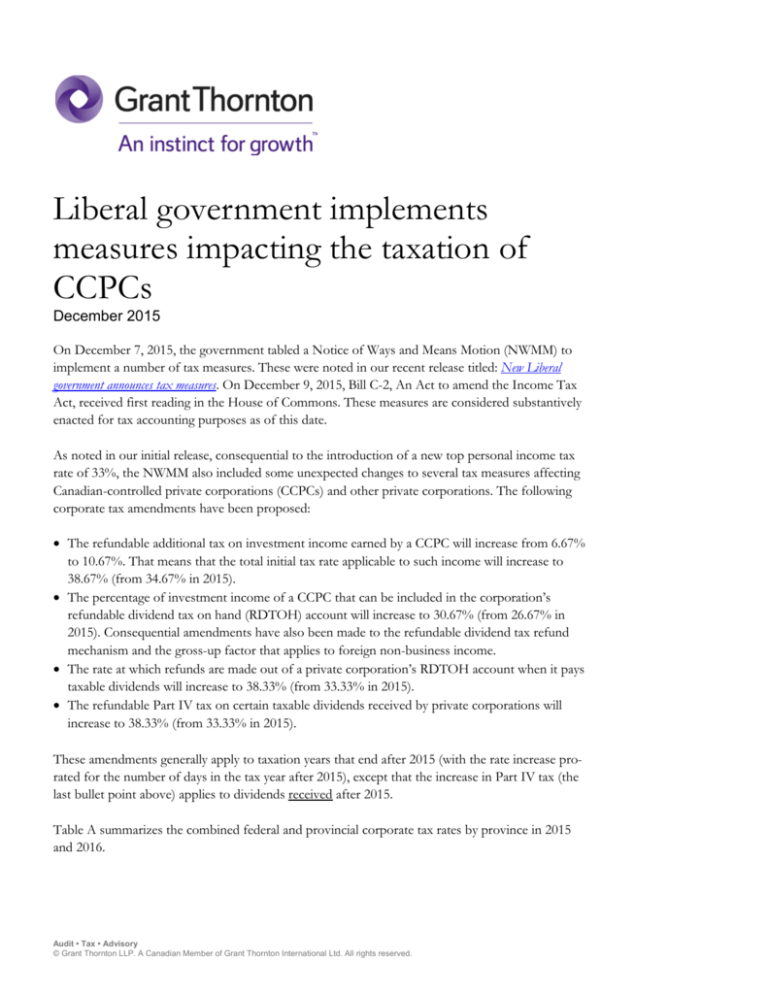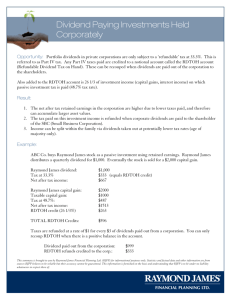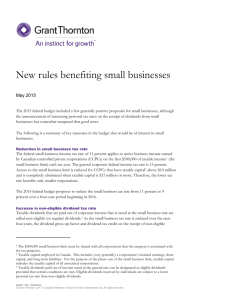
Liberal government implements
measures impacting the taxation of
CCPCs
December 2015
On December 7, 2015, the government tabled a Notice of Ways and Means Motion (NWMM) to
implement a number of tax measures. These were noted in our recent release titled: New Liberal
government announces tax measures. On December 9, 2015, Bill C-2, An Act to amend the Income Tax
Act, received first reading in the House of Commons. These measures are considered substantively
enacted for tax accounting purposes as of this date.
As noted in our initial release, consequential to the introduction of a new top personal income tax
rate of 33%, the NWMM also included some unexpected changes to several tax measures affecting
Canadian-controlled private corporations (CCPCs) and other private corporations. The following
corporate tax amendments have been proposed:
• The refundable additional tax on investment income earned by a CCPC will increase from 6.67%
to 10.67%. That means that the total initial tax rate applicable to such income will increase to
38.67% (from 34.67% in 2015).
• The percentage of investment income of a CCPC that can be included in the corporation’s
refundable dividend tax on hand (RDTOH) account will increase to 30.67% (from 26.67% in
2015). Consequential amendments have also been made to the refundable dividend tax refund
mechanism and the gross-up factor that applies to foreign non-business income.
• The rate at which refunds are made out of a private corporation’s RDTOH account when it pays
taxable dividends will increase to 38.33% (from 33.33% in 2015).
• The refundable Part IV tax on certain taxable dividends received by private corporations will
increase to 38.33% (from 33.33% in 2015).
These amendments generally apply to taxation years that end after 2015 (with the rate increase prorated for the number of days in the tax year after 2015), except that the increase in Part IV tax (the
last bullet point above) applies to dividends received after 2015.
Table A summarizes the combined federal and provincial corporate tax rates by province in 2015
and 2016.
Audit • Tax • Advisory
© Grant Thornton LLP. A Canadian Member of Grant Thornton International Ltd. All rights reserved.
Why were these changes made?
The corporate rate changes are intended to maintain the integration of the tax system for
individuals subject to the top marginal rate of tax. Integration is an important principle in our tax
system. It is based on the premise that an individual earning income through a corporation should
be in the same tax position as if that individual had earned the income directly. However,
integration is not perfect and how closely it achieves its intended purpose varies by province.
Integration of passive investment income earned by a CCPC is achieved through a refundable tax
mechanism. There are two refundable mechanisms: (1) a refundable portion of Part 1 Tax (for
investment income and capital gains) and (2) refundable Part IV tax (generally, for dividend income
received from another corporation that is not “connected” 1 with the recipient corporation). This
refundable tax paid by the corporation is refunded to the corporation when taxable dividends are
paid out to the shareholders. This tax is designed to eliminate the deferral aspect of earning
investment income in a corporation.
The 4% increase in the refundable portion of Part 1 tax is intended to increase the initial rate of tax
on investment income earned in a corporation so that it more closely approximates the new top
personal rate of tax. Column A of Table B compares the corporate deferral/prepayment of earning
and retaining interest income in a corporation to earning it personally and being subject to the top
marginal personal rate of tax. As can be seen, in most cases there is an initial tax cost to earning
investment income in a corporation, although there is a deferral benefit in Ontario, Quebec and
New Brunswick.
Similarly, Part IV tax is intended to eliminate the deferral benefit of earning certain dividend
income in a corporation (generally, dividends from a company that is not connected with the
dividend recipient). The 5% increase in the Part IV tax rate is intended to more closely approximate
the top personal rate of tax on dividend income. Eligible dividends are subject to a lower rate of tax
than regular dividends. 2 For dividends to be taxed at the lower eligible dividend tax rate, they must
be designated as dividends at the time of payment.
Table B also illustrates the corporate deferral/prepayment of earning dividends subject to Part IV
tax in a corporation versus personally (assuming the top marginal rate of tax). 3 Column C (for
eligible dividends) would generally apply to dividends received from Canadian public companies,
whereas Column D would apply where Part IV tax is applied to the receipt of regular dividends.
Whether there is an overall benefit or cost once the income is flowed through to the shareholders
in the form of dividends will depend on a number of factors, including the province of the dividend
recipient and the recipient’s marginal rate of tax. Table B summarizes the ultimate cost on flow
through to the shareholders, assuming the shareholder is subject to the top marginal rate of tax.
For interest income and capital gains, there is an overall cost to earning investment income in a
corporation in all provinces. 4 Dividends subject to Part IV tax have no cost or savings on flow
through; the end result is that the tax is ultimately paid at the shareholder level.
Basically, one which it controls or in which it owns more than 10% of the votes and value.
Most dividends paid by public companies would be eligible dividends.
3 See columns C and D
4 See columns B and G
1
2
Audit • Tax • Advisory
© Grant Thornton LLP. A Canadian Member of Grant Thornton International Ltd. All rights reserved.
What does this mean for me and my corporation?
The corporate tax changes do not significantly alter the federal integration of future investment
income earned through a CCPC and taxed at the federal top marginal personal income tax rate.
However, what has changed is an increase in the tax cost associated with keeping pre-2016 retained
earnings in a corporation and distributing taxable dividends after 2015 when the top marginal
personal income tax rates on eligible and non-eligible dividends are much higher.
The additional tax on investment income also increases the tax burden associated with being a
“specified investment business.” This is a business which principally derives income from property
(including interest, dividends, rents and royalties), except those with “more than five full-time
employees throughout the year.” Given this increase in the tax rate for investment income, this
employee test will become even more important for companies earning income from property
(such as real estate rentals). As an exception, a corporation that derives income from property from
an associated corporation that deducted those amounts from its active business income is deemed
to be receiving active business income (for example, a Holdco that rents a building, or equipment,
to an operating subsidiary corporation). This rental income would then qualify as active business
income and would not be subject to the increased rate of tax for investment income.
It is also important to note that no adjustments are being made to existing RDTOH balances. As
such, a CCPC will be required to pay a smaller dividend in 2016 and later years to recover existing
RDTOH, since the RDTOH will be refunded at a rate of 38.33% (instead of 33.33%) of taxable
dividends paid.
In addition, where the corporation has a non-calendar year-end, the 38.33% refund rate will be prorated for the number of days in the tax year that are after 2015, regardless of when the dividend is
paid. For example, a $30,000 dividend paid on November 30, 2015 for a company with a December
31, 2015 year-end will generate a dividend refund of $10,000. A $30,000 dividend paid on that same
date for a company with a June 30, 2016 year-end will generate a dividend refund of $10,745.
However, whether the corporation is subject to the 33 1/3% or 38 1/3% refund rate, the Part IV
tax rate on the receipt of dividends will be based on when the dividend is received.
The amounts in the tables are based on the assumption that the shareholder is subject to the top
marginal rate of tax. The results will differ for individuals in lower income brackets. Therefore, it is
important to review your particular situation with your tax advisor. In addition, it is unknown at this
time whether future changes to provincial personal or corporate income tax rates will be introduced
in response to these federal rate changes, or otherwise.
If you currently earn investment income through a CCPC, please contact us before the end of 2015
to discuss the implications of these changes and to determine what immediate actions, if any,
should be taken to minimize the impact of the proposed changes.
Audit • Tax • Advisory
© Grant Thornton LLP. A Canadian Member of Grant Thornton International Ltd. All rights reserved.
About Grant
Thornton in Canada
Grant Thornton LLP
is a leading Canadian
accounting and advisory
firm providing audit, tax
and advisory services
to private and public
organizations. We help
dynamic organizations
unlock their potential for
growth by providing
meaningful, actionable
advice through a broad
range of services.
Together with the
Quebec firm Raymond
Chabot Grant Thornton
LLP, Grant Thornton in
Canada has
approximately 4,000
people in offices across
Canada. Grant Thornton
LLP is a Canadian
member of Grant
Thornton International
Ltd, whose member and
correspondent firms
operate in over 100
countries worldwide.
The information
contained herein is
prepared by Grant
Thornton LLP for
information only and is
not intended to be either
a complete description of
any tax issue or the
opinion of our firm.
Changes in tax laws or
other factors could affect,
on a prospective or
retroactive basis, the
information contained
herein. You should
consult your Grant
Thornton LLP advisor to
obtain additional details
and to discuss whether
the information in this
article applies to your
specific situation.
A listing of Grant
Thornton offices and
contact information
can be found on our
website at:
www.GrantThornton.ca
Table A
2015 corporate tax rates
Combined federal and provincial tax rates
Province
Eligible for
SBD
Not eligible for SBD
With
Without MPP
MPP
Investment
Income
RDTOH
British Columbia
13.50%
26.00%
26.00%
45.67%
26.67%
Alberta
14.00%
26.00%
26.00%
45.67%
26.67%
Saskatchewan
13.00%
25.00%
27.00%
46.67%
26.67%
Manitoba
11.00%
27.00%
27.00%
46.67%
26.67%
Ontario
15.50%
25.00%
26.50%
46.17%
26.67%
Quebec
19.00%1
26.90%
26.90%
46.57%
26.67%
Quebec
15.49%
2
New Brunswick
15.00%
27.00%
27.00%
46.67%
26.67%
Nova Scotia
14.00%
31.00%
31.00%
50.67%
26.67%
Prince Edward Island
15.50%
31.00%
31.00%
50.67%
26.67%
Newfoundland & Labrador
14.00%
20.00%
29.00%
48.67%
26.67%
17.50%
30.00%
49.67%
26.67%
14.00%
1
Yukon
12.50%
2
Northwest Territories
15.00%
26.50%
26.50%
46.17%
26.67%
Nunavut
15.00%
27.00%
27.00%
46.67%
26.67%
Yukon
2016 corporate tax rates
Combined federal and provincial tax rates (based on all rate proposals up until
Dec 10, 2015)
Province
Eligible for
SBD
Not eligible for SBD
With
Without MPP
MPP
Investment
income
RDTOH
British Columbia
13.00%
26.00%
26.00%
49.67%
30.67%
Alberta
13.50%
27.00%
27.00%
50.67%
30.67%
Saskatchewan
12.50%
25.00%
27.00%
50.67%
30.67%
Manitoba
10.50%
27.00%
27.00%
50.67%
30.67%
Ontario
15.00%
25.00%
26.50%
50.17%
30.67%
26.90%
26.90%
50.57%
30.67%
18.50%
1
Quebec
14.50%
2
New Brunswick
14.50%
27.00%
27.00%
50.67%
30.67%
Nova Scotia
13.50%
31.00%
31.00%
54.67%
30.67%
Prince Edward Island
15.00%
31.00%
31.00%
54.67%
30.67%
Newfoundland & Labrador
13.50%
20.00%
29.00%
52.67%
30.67%
Yukon
13.50%1
17.50%
30.00%
53.67%
30.67%
Yukon
12.00%
2
Northwest Territories
14.50%
26.50%
26.50%
50.17%
30.67%
Nunavut
14.50%
27.00%
27.00%
50.67%
30.67%
Quebec
Notes:
1
Without MPP
2
With MPP
Audit • Tax • Advisory
© Grant Thornton LLP. A Canadian Member of Grant Thornton International Ltd. All rights reserved.
Table B
2016 integration tables
Interest income eligible for
refundable part I tax
Dividend income
Capital gains
eligible for refundable part I tax
Canadian
Investment Inco
(Assuming no lost RDTOH)
Subject to part IV tax
(Assuming no lost RDTOH)
The tables are based on
all rate proposals
announced up to Dec 10,
2015
Deferral/
(Prepayment)
Regular Dividends:
Savings/ (Cost)
Eligible Dividends:
Deferral/ (Prepayment)
Regular Dividends:
Deferral/
(Prepayment)
Savings/ (Cost)
Deferral/
(Prepayment)
Regular Dividends:
Savings/ (Cost)
British Columbia
(1.97)
(4.19)
(7.03)
2.28
Nil
(0.98)
(2.10)
Alberta
(2.67)
(4.19)
(6.62)
1.91
Nil
(1.34)
(2.10)
Saskatchewan
(2.67)
(4.05)
(8.00)
1.73
Nil
(1.34)
(2.02)
Manitoba
(0.27)
(6.15)
(0.55)
7.36
Nil
(0.14)
(3.08)
Ontario
3.36
(2.44)
1.01
6.97
Nil
1.68
(1.22)
Quebec
2.74
(1.71)
1.50
5.51
Nil
1.37
(0.85)
New Brunswick
8.08
(2.65)
5.46
13.42
Nil
4.04
(1.33)
Nova Scotia
(0.67)
(5.70)
3.25
8.64
Nil
(0.34)
(2.85)
Prince Edward Island
(3.30)
(5.97)
(4.11)
5.54
Nil
(1.65)
(2.99)
Newfoundland &
Labrador
(4.37)
(4.43)
0.14
1.07
Nil
(2.19)
(2.22)
Yukon
(5.67)
(5.94)
(13.52)
1.85
Nil
(2.84)
(2.97)
Northwest Territories
(3.12)
(1.20)
(10.00)
(2.61)
Nil
(1.56)
(0.60)
Nunavut
(6.17)
(4.58)
(5.25)
(1.98)
Nil
(3.09)
(2.29)
Audit • Tax • Advisory
© Grant Thornton LLP. A Canadian Member of Grant Thornton International Ltd. All rights reserved.









